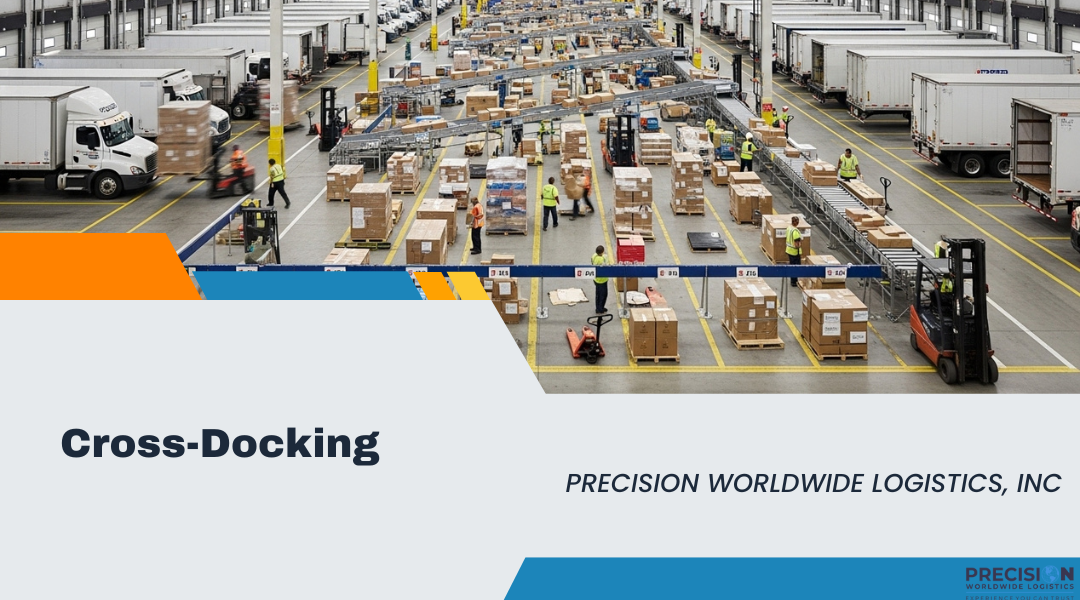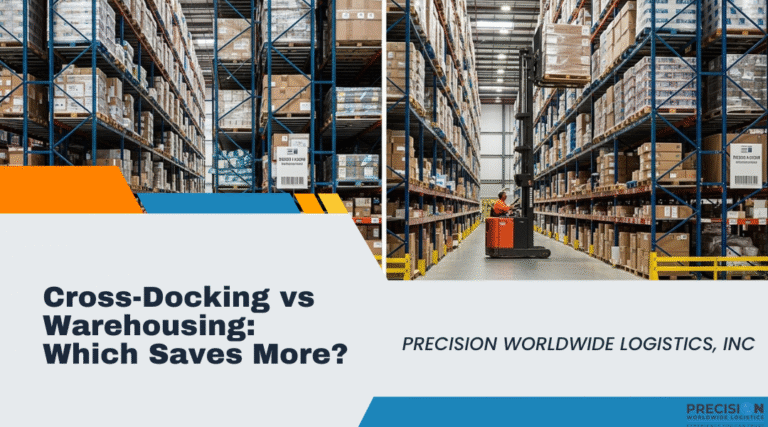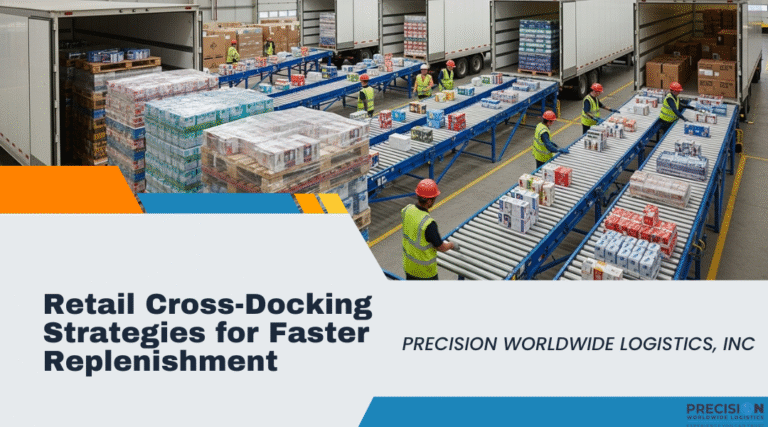Speed Up Your Supply Chain with Strategic Cross-Docking
In today’s logistics landscape, agility separates winners from also-rans. When customer expectations demand next-day delivery and inventory holding costs squeeze margins, the traditional warehouse model—receiving goods, storing them for weeks, then picking and shipping—becomes a competitive liability.
Cross-docking eliminates warehousing delays so goods reach customers faster. This logistics strategy transfers inbound shipments directly to outbound transportation with little to no storage in between, accelerating delivery timelines while dramatically reducing costs.
Precision Worldwide Logistics now offers cross-docking as an integral part of our Southern California operations. For companies moving goods through the Los Angeles area who need to reduce handling time and cut lead times, our strategically located facility provides the perfect solution—combining port proximity, operational expertise, and integrated logistics services under one roof.
What is Cross-Docking? (Definition & How It Works)
Cross-docking is a logistics practice of unloading goods from incoming trucks or containers and immediately loading them onto outbound trucks bound for their next destination, without storing the goods in between. The term comes from the physical movement of freight “across” a warehouse facility—from receiving dock to shipping dock in a continuous flow.
How the Cross-Docking Process Works
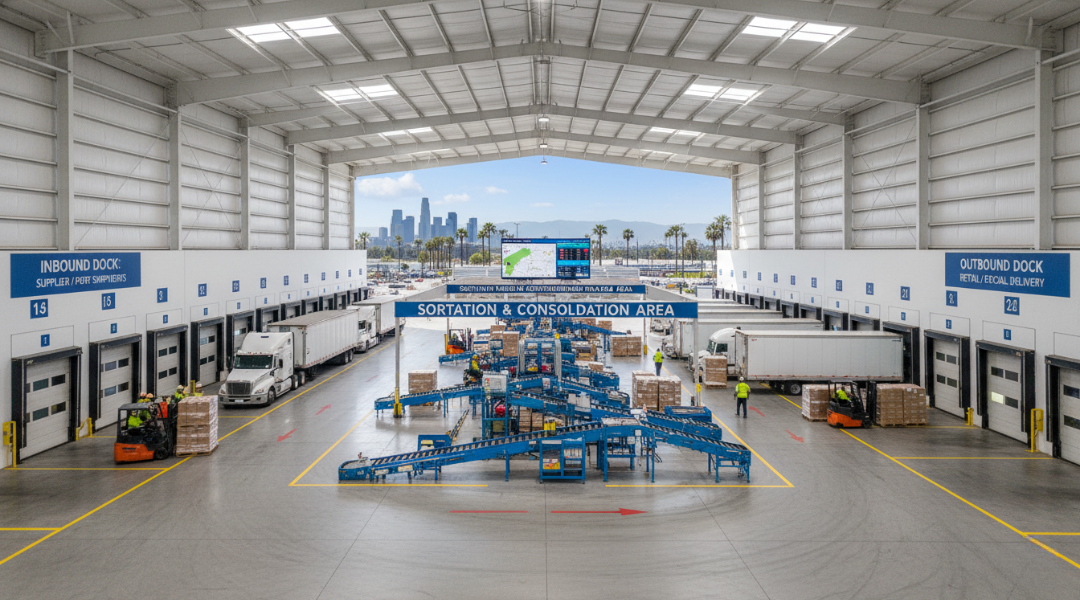
Step 1: Inbound Receipt
Products arrive at our facility from manufacturers, suppliers, or port drayage, and are assigned to a designated receiving dock. Trucks are scheduled in advance to ensure coordinated arrival timing.
Step 2: Sorting & Consolidation
Items are sorted or consolidated on the warehouse floor according to outbound orders, routes, or destinations. Importantly, goods remain on pallets or in cases—they’re never shelved or put into rack storage. Handling is kept minimal to maintain speed and reduce damage risk.
Step 3: Immediate Outbound Loading
Sorted freight moves directly to an outbound dock where trucks (or sometimes railcars) are already staged and ready for loading. The transfer happens within hours—sometimes minutes—of inbound arrival.
Step 4: Dispatch
Loaded outbound vehicles depart for their destinations, often the same day or within 24 hours of the goods arriving at the facility.
The Speed Advantage
Inventory spends virtually no time in storage during cross-docking. Many operations achieve complete cross-dock cycles in under 24 hours or even within the same shift. This rapid throughput is enabled by facility layout—typically an I-shaped or T-shaped design with inbound docks on one side and outbound docks on the other, facilitating seamless flow from one end to the other.
Types of Cross-Docking Operations
Continuous Cross-Docking
Constant flow of goods from inbound to outbound, common for fast-moving retail SKUs with predictable demand. Products arrive and immediately transfer to waiting trucks.
Consolidation Cross-Docking
Combining smaller shipments from multiple sources into one larger outbound shipment. For example, collecting products from various suppliers and consolidating them into a single full truckload destined for one retailer’s distribution center.
Deconsolidation Cross-Docking
Breaking down a large inbound shipment into several smaller outbound loads. For instance, splitting a full container into multiple local delivery trucks, each serving different store locations.
Hybrid Cross-Docking
Combining cross-dock operations with brief staging or light value-added services (labeling, quality checks) before immediate outbound loading.
Understanding these variations shows that cross-docking adapts to different business needs—Precision can configure operations to match your specific requirements.
Benefits of Cross-Docking
Accelerated Delivery Times
Cross-docking speeds the flow of goods from supplier to customer by eliminating the storage phase entirely. Products reach end destinations much faster—critical for perishable goods (food, pharmaceuticals), time-sensitive products, and high-turnover retail items.
In the Los Angeles port context specifically, cross-docking means imports can reach store shelves days sooner than if they sat in a traditional warehouse. For businesses serving the West Coast market, this speed advantage translates directly into competitive positioning.
Lower Inventory Holding Costs
Since inventory isn’t sitting in a warehouse, companies save substantially on:
- Storage costs: Reduced or eliminated rent, utilities, and facility overhead
- Capital efficiency: Less cash tied up in idle inventory
- Carrying costs: Lower insurance, security, and inventory management expenses
- Labor savings: No putaway, storage management, or order picking operations
Cross-docking minimizes the need for warehouse space, directly reducing expenses. This lean approach aligns perfectly with just-in-time (JIT) inventory strategies that modern businesses increasingly adopt to improve cash flow and reduce waste.
Reduced Handling & Product Damage
Fewer touchpoints mean significantly less risk of product damage, loss, or shrinkage. When goods transfer directly from one truck to another, they’re handled far less than if they were received, put away into rack storage, picked for orders, and staged for shipping.
By eliminating the storage step, cross-docking cuts handling by 50-70% compared to traditional warehousing. This improves product integrity, reduces labor costs, and minimizes errors. Every touch represents an opportunity for mistakes or damage—cross-docking simply removes most of those opportunities.
Streamlined Operations & Enhanced Visibility
Cross-docking simplifies operations substantially. The focus shifts to inbound scheduling coordination and outbound routing optimization. Inventory management actually becomes easier since items don’t need complex tracking through warehouse management systems—they aren’t in the facility long enough to require extensive record-keeping.
Companies gain clearer real-time visibility on what’s arriving and departing. Because the process is measured in hours rather than days or weeks, it’s easier to track and troubleshoot issues immediately when they arise.
Transportation Cost Savings
Consolidation advantages: Combining multiple partial shipments into full truckloads dramatically reduces per-unit transportation costs. Rather than sending three half-empty trucks to the same destination, cross-docking enables one full truck—cutting freight costs by 40-60%.
Optimized routing: For inbound shipments, if multiple suppliers send goods to one cross-dock facility, those can be combined to reduce the number of long-haul shipments needed.
Better carrier utilization: Coordinated scheduling means trucks spend less time waiting and more time moving, improving asset utilization for carriers and reducing costs for shippers.
Improved Customer Satisfaction
Ultimately, faster and more reliable delivery means end customers (whether stores or consumers) receive products when expected or sooner. This is particularly powerful for regional distribution around Southern California—cross-docking enables next-day or even same-day store replenishment from the port, dramatically improving in-stock rates and customer satisfaction.
Competitive Responsiveness
Markets change quickly. Cross-docking’s speed enables businesses to respond to demand spikes, promotional opportunities, or supply chain disruptions faster than competitors relying on traditional warehousing. This agility has real value in competitive markets where being first to market or maintaining availability during high-demand periods drives significant revenue.
Ideal Use Cases for Cross-Docking
High-Volume Retail Distribution
Big-box retailers and e-commerce companies moving large quantities of goods rapidly—seasonal merchandise, promotional items, or everyday high-velocity SKUs—use cross-docking at distribution centers to push products to stores without ever storing them.
Example: A shipment of consumer electronics arrives at our facility from the Port of Los Angeles. We already know which retail stores need specific quantities. We cross-dock and dispatch directly to each store location—products arrive 3-5 days faster than traditional warehouse distribution would allow.
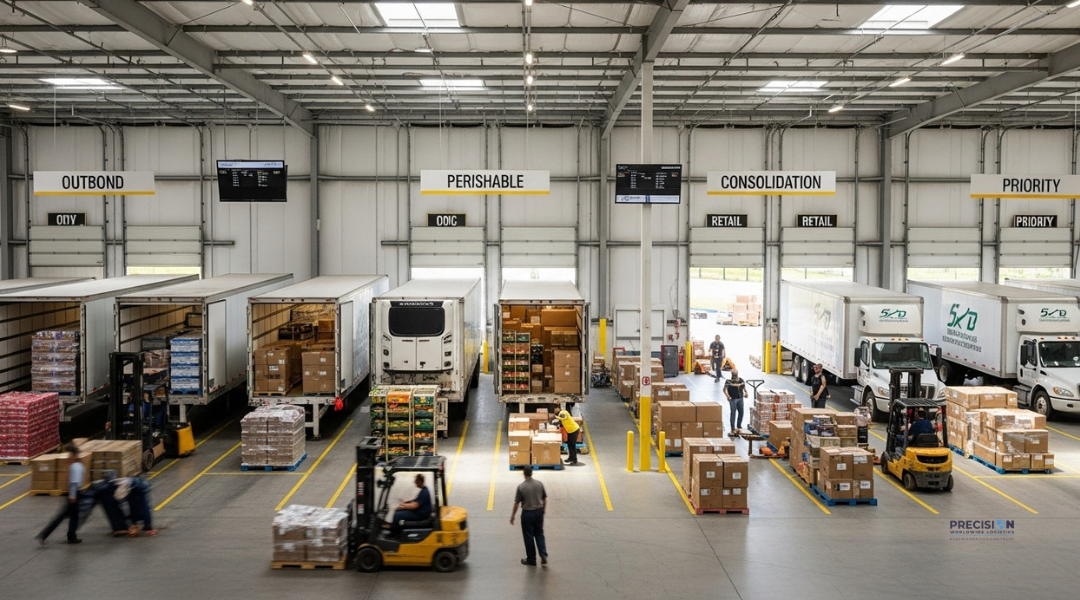
Perishables & Time-Sensitive Goods
Food distributors and grocery supply chains regularly cross-dock produce, dairy, meat, and baked goods to preserve freshness. Product arrives from farms, processors, or ports and goes straight out to stores or food service operators.
Los Angeles, as a major hub for imported produce, flowers, and specialty foods, provides an ideal environment for cross-docking these temperature-sensitive products. Cutting out warehouse dwell time can add 5-7 days of shelf life—a critical advantage for perishable goods.
Hub-and-Spoke Distribution Networks
Companies using regional hub facilities benefit enormously from cross-docking. A Southern California hub might receive full truckloads of mixed products destined for multiple local delivery routes. Cross-docking enables rapid splitting onto local trucks serving specific territories.
This model works particularly well for last-mile delivery operations, where speed and route density matter more than inventory buffering.
Limited Warehouse Space Situations
Companies with constrained storage capacity or those wanting to avoid expensive warehouse expansion can leverage cross-docking to move goods through quickly without adding square footage. Cross-docking also handles overflow during peak seasons—acting as a relief valve that prevents warehouses from becoming overwhelmed by maintaining flow-through operations.
Backordered or Priority Items
When certain goods are in high demand or backordered, cross-docking ensures they skip any queue and go straight to waiting customers or stores the moment they arrive. This responsiveness can save a critical sale or prevent a stockout situation that drives customers to competitors.
Consolidated Multi-Vendor Shipments
For businesses sourcing from multiple suppliers, cross-docking provides a consolidation point. Small shipments from various vendors combine into optimized full truckloads destined for specific customers or distribution centers. This reduces complexity and cost while improving service levels.
Southern California Logistics Advantage
The Los Angeles area, with its massive import volumes and dense consumer market, is prime territory for cross-docking. Our facility acts as a critical node where international shipments are immediately sorted and dispatched to West Coast destinations, avoiding lengthy storage entirely. The combination of port proximity, highway access, and market density makes Los Angeles ideal for cross-dock operations.
Precision Worldwide’s Cross-Docking Capabilities
Purpose-Built Facility Infrastructure
Our warehouse facility is specifically configured to support high-velocity cross-docking flows:
- Multiple dock doors: Ample capacity for simultaneous inbound and outbound operations
- Open floor space: Designated sorting areas that accommodate rapid freight movement
- Optimized layout: Strategic positioning of receiving and shipping areas for maximum efficiency
- Material handling equipment: Full complement of forklifts, pallet jacks, and conveyors
- Staging areas: Organized zones for outbound consolidation and loading
Our facility design enables the quick turnarounds that make cross-docking successful—trucks don’t wait, freight doesn’t sit, and operations flow continuously.
Advanced Coordination & Scheduling
Cross-docking success depends on precise timing. Our operational team excels at coordinating:
- Inbound appointment scheduling: Staggered arrivals that prevent dock congestion
- Outbound dispatch timing: Pre-arranged departure schedules aligned with delivery requirements
- Carrier communication: Proactive updates to trucking companies on load readiness
- Exception management: Rapid response when schedules shift or issues arise
We schedule inbound arrivals and outbound departures with precision, ensuring trucks meet trucks with minimal waiting. This coordination capability—built on 25+ years of LA logistics experience—differentiates Precision from less experienced providers.
Technology-Enabled Visibility
Our warehouse and transportation management systems are specifically configured for cross-dock scenarios:
- Real-time tracking: Scan items from inbound to outbound in one seamless process
- Automated notifications: Alerts when transfers complete, trucks depart, or exceptions occur
- Digital documentation: Instant access to BOLs, packing lists, and transfer records
- Integration capabilities: Connect with your ERP, order management, or supply chain systems
- Performance dashboards: Monitor cross-dock cycle times, accuracy rates, and throughput
Even though dwell time is measured in hours rather than days, clients maintain complete visibility throughout the cross-dock process.
Value-Added Services During Transfer
While speed is the priority, we can incorporate value-added services that don’t compromise throughput:
- Quality inspections: Quick checks for damage or discrepancies
- Labeling services: Apply retailer-specific labels or compliance markings
- Documentation handling: Insert packing slips, update paperwork, or add promotional materials
- Light assembly or kitting: Merge components or create multi-item packages
- Photography: Document condition for high-value or sensitive shipments
These services add value without sacrificing the speed advantages that make cross-docking attractive.
Integrated Port Drayage Operations
Precision’s asset-based drayage operations create a seamless port-to-customer flow:
- Our trucks pick up containers from LA/Long Beach port terminals
- Containers arrive at our facility typically within 90 minutes of port pickup
- Contents are unloaded, sorted, and cross-docked to outbound trucks
- Outbound trucks depart for final destinations—often the same day
- Empty containers return to the port within free time, avoiding per diem charges
This integrated capability—handling the entire chain from port to delivery under one roof—is a significant differentiator. Most providers require coordination across multiple vendors, creating handoff delays and accountability gaps. Precision manages everything, ensuring seamless cross-dock operations from ship to final destination.
Skilled Team & Flexible Operations
Our experienced team makes cross-docking work:
- Trained staff: Forklift operators and logistics coordinators who understand time-critical operations
- Extended hours: Flexible scheduling including evening and weekend operations when needed
- High-velocity expertise: 25+ years handling rapid-turnaround freight in the LA market
- Problem-solving mindset: Proactive identification and resolution of potential delays
- Safety focus: Efficient operations never compromise safety standards
Scalable Capacity
Whether handling a single pallet transfer or multiple full truckload swaps daily, we have capacity and equipment to scale:
- Small operations: Even single-pallet cross-dock transfers benefit from our efficiency
- Large-scale programs: Capability to handle consistent high-volume daily cross-dock operations
- Surge capacity: Able to accommodate seasonal peaks or promotional event volumes
- Equipment resources: Sufficient material handling equipment to prevent bottlenecks
This flexibility invites businesses of all sizes to leverage our cross-docking capabilities.
Cross-Docking vs. Warehousing vs. Transloading
Understanding the distinctions helps you choose the right approach for your specific supply chain needs.
Cross-Docking vs. Traditional Warehousing
| Aspect | Cross-Docking | Traditional Warehousing |
| Storage time | Hours (minutes to 24 hours) | Days to months |
| Primary goal | Speed and flow | Inventory buffer and flexibility |
| Handling | Minimal (dock-to-dock) | Multiple touches (receiving, putaway, picking, shipping) |
| Inventory holding | Near zero | Substantial |
| Best for | Fast-moving goods, time-sensitive products | Variable demand, slower-moving inventory |
| Lead time | Shortest possible | Longer, more flexible |
| Cost structure | Lower overhead, higher coordination | Higher storage/handling, lower coordination needs |
Traditional warehousing involves storing inventory—sometimes for weeks or months—which provides a demand buffer but adds lead time and cost. This approach works when:
- Demand is unpredictable and requires safety stock
- Products are slow-moving or seasonal
- Order consolidation happens over extended periods
- You need inventory available for immediate customer orders
Cross-docking emphasizes speed by swiftly transferring goods from incoming to outgoing vehicles, significantly shortening lead time. This approach excels when:
- Demand is predictable or pre-sold
- Products move quickly with high turnover rates
- Speed to market creates competitive advantage
- Reducing inventory carrying costs is a priority
The key distinction: Warehousing prioritizes storage and inventory holding for demand buffering; cross-docking prioritizes rapid throughput with minimal to no storage.
Cross-Docking vs. Transloading
While these services can occur in similar facilities and even be combined, they serve different purposes:
Cross-docking typically involves:
- Same transportation mode (usually truck-to-truck)
- Domestic distribution focus
- Speed as primary objective
- Sorting and consolidating for efficiency
- Minimal or no cargo reconfiguration
Transloading typically involves:
- Different transportation modes (ship/rail to truck)
- International shipments or long-haul optimization
- Mode efficiency as primary objective
- Breaking down or consolidating loads between modes
- Often includes repalletizing or repackaging
They can work together: Precision can transload goods from ocean containers to trucks, then immediately cross-dock those goods onto local delivery trucks destined for multiple store locations. This combined capability—handling both mode transfer and rapid distribution—demonstrates our comprehensive logistics expertise.
When to Choose Each Approach
Choose cross-docking when:
- Speed matters more than inventory flexibility
- Goods are pre-sold or have predictable demand
- You’re distributing within a regional area
- Reducing inventory carrying costs is critical
- Products are time-sensitive or perishable
Choose warehousing when:
- Demand is variable or unpredictable
- You need safety stock for customer service
- Order consolidation happens over days or weeks
- Products are slow-moving or seasonal
- Inventory availability for immediate shipment matters
Choose transloading when:
- Switching between transportation modes
- Optimizing international shipments arriving at ports
- Consolidating or splitting loads for efficiency
- Serving multiple final destinations from one inbound shipment
Choose Precision for all three: Our comprehensive capabilities mean you can implement the best strategy for each shipment type without changing providers.
Why Choose Precision for Cross-Docking in Los Angeles?
Strategic Southern California Location
Our cross-dock facility sits minutes from the Ports of Los Angeles and Long Beach and provides immediate access to major interstate highways (I-5, I-710, I-605, I-10). This location enables:
- Rapid port-to-facility transit: Containers arrive at our dock within 90 minutes of terminal pickup
- Fast distribution: Quick access to all Southern California markets plus routes to Nevada, Arizona, and beyond
- Regional hub positioning: Central to the nation’s largest consumer market and import gateway
Being at the heart of LA’s logistics network minimizes transit time between port, our dock, and your customers—giving you a clear regional advantage.
All-in-One Logistics Partner
Precision handles the entire journey, eliminating coordination headaches:
- Port drayage: Pick up containers from LA/Long Beach terminals with our owned equipment
- Cross-docking: Sort and transfer at our facility with precision timing
- Final delivery: Transport to destinations via our trucking fleet or trusted carrier network
- Value-added services: Inspections, labeling, documentation as needed
- Technology integration: Visibility from port pickup through final delivery
This single-provider solution reduces vendor management complexity and ensures accountability at every step. When issues arise, there’s one point of contact and clear responsibility.
25+ Years of Time-Critical Experience
Our operations team brings decades of experience in LA’s demanding logistics environment:
- Port expertise: Deep understanding of terminal operations, chassis management, and drayage optimization
- Efficiency focus: Track record of rapid turnarounds even during high-volume periods
- Problem-solving capability: Experience navigating port congestion, equipment shortages, and unexpected challenges
- Deadline commitment: We treat your delivery windows as sacred—our mindset is critical for successful cross-docking
This experience translates directly into reliable cross-dock performance when timing is everything.
Customized Cross-Dock Solutions
Every business has unique requirements. We design cross-dock programs that fit your specific needs:
- Consolidation programs: Combine multiple suppliers’ shipments into optimized outbound loads
- Deconsolidation services: Split incoming loads for multiple delivery locations
- Scheduled cross-docks: Regular, predictable flows with standing appointments
- On-demand cross-docks: Flexible arrangements for variable or seasonal needs
- Hybrid approaches: Combination of cross-dock and brief staging when needed
This flexibility sets us apart from rigid, one-size-fits-all providers. We adapt to your business, not vice versa.
Superior Reliability & Communication
Cross-docking requires tight coordination across multiple parties. Precision excels in:
- Proactive updates: Regular communication at each milestone (arrival, sorting, loading, departure)
- Exception management: Immediate notification and action when schedules shift
- Carrier coordination: Working with your preferred carriers or providing our own capacity
- Schedule adherence: Consistent on-time performance that builds trust
- Responsive support: Direct access to operations team members who know your account
You can confidently adopt cross-docking knowing our communication and reliability eliminate typical coordination concerns.
Demonstrated Cost Efficiency
Clients using Precision’s cross-docking services typically experience:
- 30-50% reduction in inventory holding costs
- 3-5 day improvement in delivery speed to market
- Eliminated or dramatically reduced per diem and demurrage charges
- 20-35% lower transportation costs through consolidation
- Improved inventory turns and cash flow
We help analyze your current logistics flow to demonstrate specific savings opportunities. Our competitive rates in the LA market—combined with operational efficiency—deliver measurable value.
Safety, Security & Compliance
Despite the rapid pace of cross-dock operations, we never compromise:
- Safety protocols: Industry-leading practices protecting both staff and freight
- Secure facility: 24/7 surveillance, controlled access, and monitored cargo areas
- Cargo insurance: Comprehensive coverage protecting your goods during transfer
- Compliance adherence: All operations meet regulatory requirements and customer specifications
- Quality assurance: Accuracy checks and damage prevention procedures
Peace of mind comes standard with every cross-dock operation.
Get Started with Cross-Docking Services
Streamline Your Supply Chain Today
Ready to eliminate unnecessary delays and accelerate your distribution? Cross-docking with Precision Worldwide Logistics can transform your supply chain performance—reducing costs while improving delivery speed.
Every hour your inventory sits idle costs money and creates risk. Cross-docking keeps products moving, customers satisfied, and your business agile.
Request a Free Cross-Dock Consultation
Our logistics experts will:
- Analyze your current distribution process
- Identify cross-docking opportunities in your supply chain
- Develop a customized implementation plan
- Provide clear cost-benefit projections
- Answer all your questions about making the transition
Contact Precision Worldwide Logistics:
📞 Call: (800) 937-1599
✉️ Email: [email protected]
🌐 Visit: www.precisioninc.com
We typically respond within 2 hours during business days. Get the conversation started today and discover how cross-docking can give you a competitive edge in the fast-paced Los Angeles logistics market.
Frequently Asked Questions about Cross-Docking
Q: How is cross-docking different from regular warehousing?
A: In cross-docking, products don’t get stored—they transfer directly from inbound shipments to outbound shipments, often within hours of arrival. Regular warehousing involves placing goods on racks and holding them until needed, which can be days, weeks, or months. Cross-docking eliminates that storage step to speed delivery and reduce holding costs significantly.
Q: What types of products are suitable for cross-docking?
A: Cross-docking works best for fast-moving products, perishable goods that need quick market delivery, and time-sensitive items. Common examples include retail merchandise with steady demand, groceries and food products, consumer packaged goods, promotional items, and pre-sold products. It’s also ideal when multiple incoming shipments need immediate sorting into outgoing loads—such as consolidating supplier goods heading to a single customer.
Q: Do I need a full truckload to use cross-docking?
A: No. Consolidation cross-docking combines partial loads from different sources into full trucks, so even if your individual shipment isn’t a full load, we can merge it with others heading the same direction. Conversely, a full truck can be deconsolidated into smaller loads for multiple delivery points. Precision handles both scenarios effectively.
Q: Can Precision cross-dock imported containers from the port?
A: Absolutely. We regularly pick up containers from Los Angeles and Long Beach ports, deliver them directly to our facility, and cross-dock the contents into domestic trailers or trucks for immediate onward delivery. Your import cargo skips long-term storage and gets on the road faster—typically the same day or within 24 hours. Our port proximity and asset-based drayage fleet make this process smooth and reliable.
Q: What infrastructure is needed for successful cross-docking?
A: Cross-docking requires a well-designed facility with multiple dock bays, open floor space for sorting, and robust scheduling systems. Precision’s warehouse was designed specifically to support cross-dock operations—we have dedicated docks, material handling equipment, and a team experienced in coordinating inbound/outbound timing. Essentially, we provide all the infrastructure so you don’t need to invest in it yourself.
Q: How do you ensure accuracy if goods aren’t being stored and tracked?
A: Even though products move quickly through our facility, every item is scanned upon receipt and again at outbound loading. Our warehouse management system tracks each piece through the cross-dock process, maintaining complete accuracy. Our experienced team performs visual verification, and we can photograph shipments or conduct quality checks as needed. Speed doesn’t mean sacrificing accuracy—it just requires discipline and good systems.
Q: Is cross-docking right for my business?
A: Cross-docking works best when you have predictable demand, fast-moving products, or time-sensitive goods. It’s ideal if you’re looking to reduce inventory holding costs and speed products to market. However, if your demand is highly variable, you carry slow-moving inventory, or you need significant safety stock, traditional warehousing might be more appropriate. Contact us for a consultation—we’ll honestly assess whether cross-docking fits your specific situation.
Q: How quickly can you implement a cross-docking program?
A: For most businesses, we can establish cross-dock operations within 2-4 weeks. This includes process design, system integration, staff training, and trial runs. Simple cross-dock programs with straightforward flows can start even faster. We work at your pace to ensure a smooth transition that doesn’t disrupt your existing operations.
Q: What are the cost savings compared to traditional warehousing?
A: Most clients see 25-40% reduction in total distribution costs through cross-docking, primarily from eliminated storage fees, reduced handling labor, faster inventory turns, and improved transportation efficiency. Specific savings depend on your current cost structure and volume. Request a consultation, and we’ll model your potential savings based on actual data.
Q: Can you handle both cross-docking and traditional warehousing for the same customer?
A: Yes. Many of our clients use cross-docking for fast-moving products while warehousing slower-moving items. We can design hybrid solutions that optimize each product category based on its specific characteristics and demand patterns. This flexibility ensures you always use the most efficient approach for each situation.
Precision Worldwide Logistics – Accelerating Supply Chains in Southern California Since 1999

